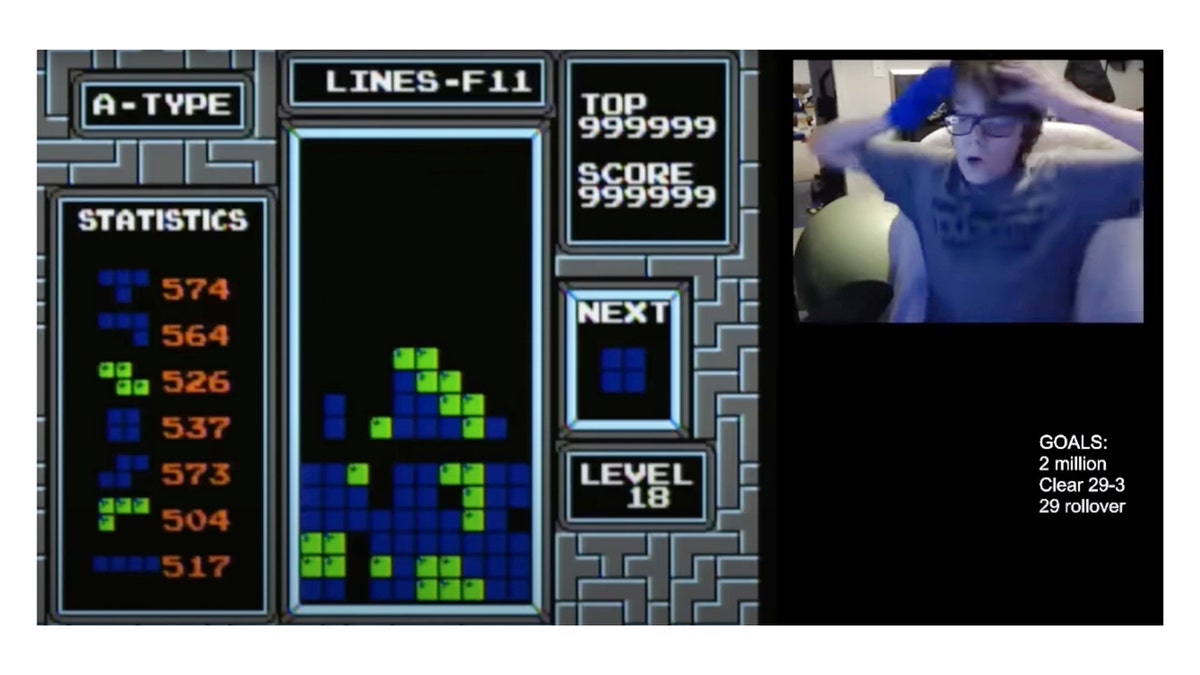Boy, 13, becomes first documented player to beat Tetris
- Willis Gibson, 13, became the first player confirmed to have “beaten” Tetris on Dec. 21.
- Gibson, known online as “blue scuti,” reached the 157th level of the four-decade-old Nintendo classic before the game’s code began glitching out, crashing it.
- “Congratulations to ‘blue scuti’ for achieving this extraordinary accomplishment, a feat that defies all preconceived limits of this legendary game,” Tetris CEO Maya Rogers said of Gibson in a statement.
The falling-block video game Tetris has met its match in 13-year-old Willis Gibson, who has become the first player to officially “beat” the original Nintendo version of the game — by breaking it.
Technically, Willis — aka “blue scuti” in the gaming world — made it to what gamers call a “kill screen,” a point where the Tetris code glitches, crashing the game. That might not sound like much of a victory to anyone thinking that only high scores count, but it’s a highly coveted achievement in the world of video games, where records involve pushing hardware and software to their limits. And beyond.
It’s also a very big deal for players of Tetris, which many had long considered unbeatable. That’s partly because the game doesn’t have a scripted ending; those four-block shapes just keep falling no matter how good you get at stacking them into disappearing rows. Top players continued to find ways to extend their winning streaks by staying in the game to reach higher and higher levels, but in the end, the game beat them all.
OFFICIAL TRAILER OF GRAND THEFT AUTO VI LEAKED JUST HOURS BEFORE PLANNED RELEASE TIME
Until, that is, Willis managed on Dec. 21 to trigger a kill screen on Level 157, which the gaming world takes as a victory over the game — something along the lines of pushing the software past its own limits.
The makers of Tetris agree. “Congratulations to ‘blue scuti’ for achieving this extraordinary accomplishment, a feat that defies all preconceived limits of this legendary game,” Tetris CEO Maya Rogers said in a statement. Rogers noted that Tetris will celebrate its 40th anniversary this year and called Willis’ victory a “monumental achievement.”
It’s been a very long road. Early on, “the Tetris scene people didn’t even know how to get to these higher levels,” said David Macdonald, a gaming YouTuber who has chronicled the gaming industry for years. “They were just stuck in the 20s and 30s because they just didn’t know techniques to get any further.” Level 29 posed an especially tough roadblock because the blocks began falling more quickly than the in-game controller could respond.

Willis Gibson, 13, reacts after a game of Tetris. (Willis Gibson via AP)
Eventually players found ways to make progress, as Macdonald chronicled in his detailed video on Willis’ victory. In 2011, one got to Level 30 using a technique called “hypertapping,” in which a player could rhythmically vibrate their fingers to move the game controller faster than the game’s built-in speed. That technique took players to level 35 by 2018, after which they hit a wall.
The next big thing came in 2020 when a gamer combined a multifinger technique originally used on arcade video games with a finger positioned on the bottom of the controller to push it against another finger on the top. Called “rolling,” this much speedier approach helped one player reach Level 95 in 2022.
Then other obstacles arose. Because the original Tetris developers had never counted on players pushing the game’s limits so aggressively, bizarre quirks began to crop up at higher levels. One particularly difficult issue arose with the game’s color palette, which traditionally cycled through 10 easily distinguished patterns. Starting at level 138, though, random color combinations began to appear — some of which made it much harder to distinguish the blocks from the game’s black background.
NINTENDO CANCELS 2024 VIDEO GAME SHOWCASE IN JAPAN AFTER RECEIVING PERSISTENT THREATS
Two particularly devilish patterns — one a dim combination of dark blues and greens later dubbed “Dusk,” the other composed of black, gray and white blocks called “Charcoal” — proved taxing for players. When combined with the strain of increasingly longer games, which could run 40 minutes or more, progress slowed again. It took a Tetris-playing AI program dubbed StackRabbit to break that logjam by helping map out just where players might happen across a glitch resulting in a kill screen, and finally beat the game.
StackRabbit, which managed to make it all the way to Level 237 before crashing the game, ran on a modified version of Tetris, so its achievements aren’t strictly comparable to those of human players. And its findings weren’t immediately applicable to the human-played game, either. But its runs clearly demonstrated that game-ending glitches could be triggered by very specific events, such as which block pieces were in play or how many lines a player cleared at once.
That let human players take over the task of mapping all possible scenarios that could cause such crashes in the original game. These typically resulted when the game’s decade-old code lost its place and began reading its next instructions from the wrong location, generally resulting in garbage input. A massive effort spurred by StackRabbit’s experience eventually led to the compilation of a large spreadsheet that detailed which game levels and which specific conditions were most likely to lead to a crash.
CLICK HERE TO GET THE FOX NEWS APP
That’s what compelled Willis to make his run for the record. Yet even he appeared shocked when he crashed the game at Level 157. In his livestream video, he appears to hyperventilate before barely gasping “Oh my God” several times, clutching his temples and worrying that he might be passing out. After cupping his hands over his mouth in an apparent attempt to regulate his breathing, he finally exclaims, “I can’t feel my fingers.”

